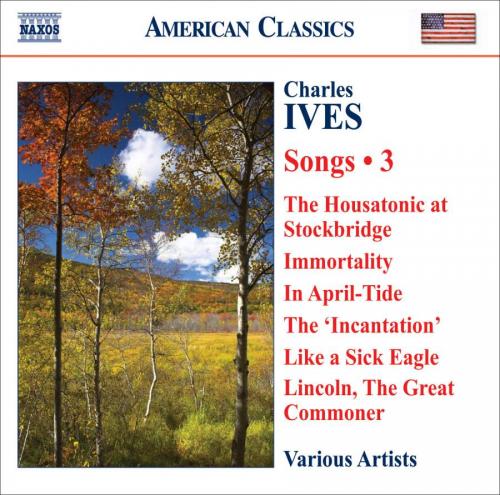
Songs • 5
When, in 1922, Charles Ives published a volume entitled 114 Songs, he was indirectly drawing attention to the fact that the genre played a central part in his output. 85 years on and, for all that his wider reputation may rest on orchestral, chamber and piano music, songs represent the heart of his creative thinking. Nor was that initial volume comprehensive; Ives having written nearly 200 songs, of which this edition includes all those he completed. The expressive variety is vast: indeed, the gradual evolution of Ives’s songwriting, from those drawing on Austro-German Lieder and English parlour-song traditions to ones that evince anarchic humour as keenly as others do profound vision, is analogous to the evolution of American music over the last quarter of the nineteenth and first quarter of the twentieth centuries.
Although it would be possible to collate Ives’s songs according to type, the alphabetic approach adopted by this edition ensures each volume (of which this disc is the fifth) contains a representative cross-section of his achievement. A wide range of poets is set, including a number of (mainly early) German settings as well as forays into French and Italian writers. The temporal distance (1887–1926) traversed by these songs is as little compared to their stylistic diversity or their emotional range.
The extent to which Ives reworked songs throughout his career is considerable, whether substituting a text or reworking the actual music. To this end, songs with a musical or textual connection are crosslinked accordingly (i.e. in brackets at the end of the relevant paragraph).
One of Ives’s most finely realized later songs, Paracelcus (1921) is a wide-ranging setting of verse by Robert Browning on the relationship of human and divine thought; one unfolding in a gradual decrescendo as the emphasis alters from opposing strength to mutual love.
From among Ives’s last songs, Peaks (1923) sets a poem by Henry Bellamann with an ambivalence in terms of tonality and texture that serves to point up the essential ambiguity of the author’s vision.
With its anonymous text, A Perfect Day (1902) is not a setting of the evergreen Victorian ballad but a song whose wistful longing combined with undoubted melodic poise make it highly appealing in its own right.
To a poem by Monica Peveril Turnbull, Pictures (1906) draws on the text’s abrupt juxtaposition of images in a setting whose expressive contrasts (with depictions of, respectively, ‘The Cornfield’, ‘The Sea’, ‘The Moor’ and ‘Night’) are balanced by the music’s resourceful motivic unity.
The setting of an ominous poem by Robert Underwood Johnson, Premonitions (1921) confronts its inward fatalism with an outward defiance to a degree which typifies Ives’ final phase of composition.
Set to an anonymous text (as translated by Moreau Delano), Qu’il m’irait bien (1897) has a wit and insouciance as to confirm that Ives was fully conversant with the earlier songs of Fauré and Debussy.
An almost improvisatory setting of William Wordsworth, The Rainbow (1921) is best summed up by its subtitle—‘So May It Be!’—which underpins a reflection on divine providence occasioned by the image.
Setting an epigram by Elizabeth York Case and James T. Bixby, Religion (1910) declaims a ‘belief’ that is felt but not spoken, and with a piano postlude that gently and yet insistently confirms this conviction.
With an epigraph by William Wordsworth (“The music in my heart I bore, Long after it was heard no more”), Remembrance (1921) sets Ives’ own evocation of his father’s playing as heard from across a lake.
One of the most uncompromising songs of Ives’s middle years, Requiem (1911) sets Robert Louis Stevenson’s ‘poem within a poem’ with a forceful rhetoric thrown into relief by the echo effects at the end.
Set to his own lines, Resolution (1921) is among the shortest of Ives’s later songs, telling of the need for Faith to guide one on life’s journey.
One of Ives’s first songs, Rock of Ages (1892) sets Augustus Montague Toplady’s text as a ‘Sacred Solo’; with a piano part whose methodical and part-writing suggests that it may have been conceived for organ.
Setting lines by Leigh Hunt, the ingratiating veneer of Romanzo (di Central Park) (1911) belies this satire on the ‘commercial’ love-song: one made explicit by Ives’s jibe at Victor Herbert in the postscript. With its expressive vocal line and skilful piano writing, Ives’s first (German) version of Helmine von Chézy’s Rosamunde (1898) is a refreshing slant on a text made famous by Schubert (see also below, track 15).
Ives’s second version of Rosamunde (1901), using Bélanger’s French translation, lowers the tessitura of the voice part and opens out the piano writing for a richer and more fervent effect (see also above, track 14).
The setting of a wistful poem by Karl Stieler, Rosenzweige (1902) is a limpid and unaffected song in which the voice and piano are deftly intertwined (see also Volume 1, track 5, Naxos 8.559269, and below, track 22).
For this setting of Percy Bysshe Shelley’s Rough Wind (1902), Ives again used the main theme from the opening movement of his First Symphony, replete with densely chorded piano writing that almost overwhelms the often fraught vocal line by the close (see also Volume 4, track 27, Naxos 8.559272).
To a text by Charles Edmund Merrill Jr (itself likely adapted from traditional verse), A Scotch Lullaby (1896) avoids sentimentality by the elegance of its vocal line and its equally deft piano writing.
Among Ives’s last songs, A Sea Dirge (1925) draws on one of William Shakespeare’s songs for Ariel from The Tempest in what is surely the darkest and most forbidding setting these lines have ever received.
With its gently undulating vocal line and modally-inflected piano part, The Sea of Sleep (1903) is an affecting and discreetly resourceful setting of the anonymous text (see also Volume 6, track 7, Naxos 8.559274).
Typically scabrous, The See’r (1920) sets Ives’s text in an evocation of old age where the voice is made secondary to effusive piano writing.
A winsome setting of Christian Winther (as translated by Edmund Lobedanz), Sehnsucht (1902) is notably assured in the treatment of its material (see also Volume 1, track 5, Naxos 8.559269, and above, track 16).
With its increasingly quixotic vocal line and polytonal piano arpeggios, September (1920) is a defiantly individual setting of lines by Folgone de San Gimignano (in the translation by Dante Gabriel Rossetti).
In contrast, the setting of James Greenleaf Whittier’s Serenity (1919) features a gently intoned vocal line and a piano part whose tolling repetition make it one of Ives’ most ethereal and mesmeric songs.
Contrast again with The Side Show (1921), a pert ditty “in a moderate waltz time” to Ives’s own text and whose unassuming demeanour may conceal an ironic intention on the composer’s part.
Ives’s first song, Slow March (1887) is a simple but never gauche setting of lines by Lynne Brewster ‘and other Ives family members’ that aptly fulfills its inscription “to the children’s faithful friend”.
Among the briefest of all Ives’s songs, Slugging a Vampire (1902) sets his own text in what is ostensibly a parody occasioned by a rebuff concerning the use of his intended text (see also Volume 6, track 1, Naxos 8.559274).
A study in polarity, to Ives’s own text on the immutability of nature, Soliloquy (1916) opens with a half-intoned preface then explodes in music whose sweeping piano arpeggios ideally require two players.
The ‘college song’ A Son of a Gambolier (1895) is notable for its rhythmic animation and a text (anonymous but likely by Ives) that occupies only a small part of the music, which ends with a ‘Kazoo Chorus’ in which whatever winds and strings are on hand can join in.
By contrast, Song (1897) is a ‘parlour’ number – the setting of whose text, by Hartley Coleridge, neatly combines sentiment with ardency.
A didactic instance of Ives’s self-debunking is A Song - For Anything (1888). This began as the teenage composer’s awkward setting of lines from Psalm 51 (in the translation by Nahum Tate and Nicholas Brady), as the (often performed) sacred song Hear My Prayer, O Lord; then, thirty years later, Ives decided to illustrate “how inferior music is inclined to follow inferior words, and vice-versa” by appending his own texts: first, a love-song entitled When the Waves Softly Sigh; secondly, a parting song to one’s college entitled Yale, Farewell!.
With a text by Greville Phillimore, Song for Harvest Season (1894) features a florid vocal line over an organ contribution which may in part be replaced by cornet and trumpet (neither included here).
One of Ives’s most radical earlier songs (which may explain the reuse of its music), The Song of the Dead (1898) sets Rudyard Kipling’s poem as a baleful marchpast whose dour sentiments clearly struck a keen resonance (see also Volume 2, track 8, Naxos 8.559270, and Volume 6, track 17, Naxos 8.559274).
To a text by Adolf Heyduk (translated by Natalie Macfarren), Songs my Mother Taught Me (1900) has a warmth and intimacy which, devoid of sentimentality, have made it among Ives’s most performed songs.
When setting this music to Heine, Ives made a parallel setting of verse by Harmony Twichell (Mrs Ives) as The South Wind (1908), which exudes a similarly calm melancholy (see also Volume 3, track 31, Naxos 8.559271).
Another setting of Harmony Twichell, Spring Song (1907) clothes its slight lyric in music of evident freshness and elegance, as well as featuring a tellingly literal realization of the poem’s final words.
Ives’s last original song, Sunrise(1926) was left as a near-illegible sketch and realised after his death by John Kirkpatrick. Setting the composer’s own text, and featuring a part for violin that mediates between voice and piano, its contemplation of decay and renewal is most likely a metaphor for Ives’s failing creativity, while its uniquely rarified intensity places it firmly among the greatest of all his songs.
Inimitably Ivesian, Swimmers (1915) treats Louis Untermeyer’s text as a paean to human mastery of natural forces, achieved by a supreme effort of will that is graphically reflected in the seismic piano writing.
Richard Whitehouse


